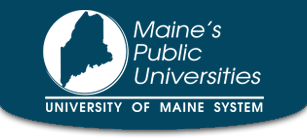Thanks to innovations in admissions, improved retention and increased transfers, the System has now increased year-over-year enrollment for four straight semesters and more students are pursuing master’s and doctoral degrees through UMS than ever
ORONO, Maine — After its biggest fall enrollment since 2021 and the best return rate in its history, the University of Maine System (UMS) is seeing another semester of student growth.
The System has now increased enrollment year-over-year in four consecutive semesters: spring 2024, summer 2024, fall 2024 and spring 2025, and is serving more students pursuing master’s and doctoral degrees than ever before.
Public colleges and universities in Maine traditionally report on their official spring semester enrollment based on a count of their students on Feb. 15. As of that day, UMS spring semester enrollment is up 4.4% from one year ago, with 24,594 students enrolled.
It is the highest spring semester enrollment for UMS since 2021.
An additional 2,721 high school students who are earning free college credit and reducing their time to a four-year degree and the Maine workforce through UMS this spring are not included in the overall enrollment figures.
“Semester after semester, Maine’s public universities are recruiting and retaining more students. That’s great news for the upward mobility of those students and their families and for the growth of Maine’s workforce and economy,” said Chancellor Dannel Malloy. “Our enrollment increases are especially impressive given the demographic challenges of Maine and New England and demonstrate that our innovations in access and affordability, academic programming and student success are paying off for our System and this state.”
All of Maine’s public universities are showing enrollment growth over last spring, with the greatest gains at the University of Maine at Presque Isle, where this spring’s enrollment is 41.2% higher than a year ago because of the popularity of its entirely online competency-based YourPace adult degree completion program (External Site).
Across the System, undergraduate enrollment (19,317 students) has increased by 3.8% over last spring, while graduate enrollment (5,007 students) has grown 6.6%.
Driven by employer demand for professionals with advanced degrees and expanded academic offerings, the System is experiencing its highest graduate enrollment in history this spring. Graduate programs aligned with the state’s workforce needs have expanded enrollment at the University of Southern Maine (USM), the University of Maine at Farmington (UMF), the University of Maine at Augusta, the University of Maine at Fort Kent and UMPI.
For example, UMF’s master’s of science in education degree programs (External Site) now enroll a total of 181 students, an increase of more than 41% from spring 2024, and USM’s master’s of social work program (External Site) now enrolls 150 students, a 35% increase from one year ago.
Included in graduate enrollment data are the record number of students (745) pursuing doctoral degrees, mostly at the University of Maine, which has a regional campus in Machias, and also at USM and UMFK — up 10.5% compared to last spring and 34.7% from five years ago. Ph.D. production is important to Maine’s competitiveness in economic sectors like life sciences and was central to the Carnegie Classification reaffirming UMaine’s prestigious R1 designation last week (External Site). A new online Doctor of Engineering in Engineering Technology (External Site) that launched at UMaine in the fall already has 30 students and is furthering the System’s goal of doubling its output of engineering and degree graduates.
The University of Maine School of Law is also experiencing its highest spring semester enrollment since 2013.
Innovations in admissions, improved retention and increased transfers
Colleges and universities typically experience a marked drop in enrollment between the fall and spring semesters, as students complete their degrees in December or decide not to return.
However, UMS showed a smaller decrease (2.7%) from fall to spring than in past years as a result of admission innovations, retention improvements and an influx of transfer students.
The System began directly admitting promising high school students starting this academic year, and last July, it announced that admission would be guaranteed to graduates of the state’s community colleges.
In total, more than 1,200 undergraduate students transferred to UMS this semester, a 26.5% increase from a year ago and 50.3% more than had transferred five years ago. About half of these transfers were adults who had previously paused their postsecondary education and are now seeking to complete a door-opening degree through UMPI’s YourPace, while about one-fifth came to UMS from Maine’s community colleges, which is generally consistent with past years’ spring transfer trends.
More students who start are staying in the System thanks to enhanced academic and mental health supports and the expansion of engaging hands-on workforce preparation-oriented learning opportunities, including those funded by the Harold Alfond Foundation through UMS TRANSFORMS
The number of credit hours being taken through Maine’s public universities this semester has increased more than 5% from last year, reflecting the relevance of the System’s academic offerings and its region-leading affordability. According to publicly available information, UMaine’s FY25 in-state credit hour rate is 40% less than the average cost of the R1 flagships in New Hampshire, Massachusetts and Connecticut — the states that sent the most students to Maine this fall — while the out-of-state undergraduate credit hour rate is 25% lower.
UMS spring enrollment information is available on its transparent data dashboard (External Site). A detailed enrollment report will be presented to the Board of Trustees at their March 10 meeting in Orono.
About the University of Maine System
The University of Maine System (UMS) is the state’s largest driver of educational attainment and economic development and its seven public universities and law school are the most affordable in New England. Over the past two decades, UMS has awarded 106,362 degrees and spurred and strengthened thousands of small Maine businesses through its world-class research and development activities. For more information, visit www.maine.edu.
Media Contact:
Samantha Warren
Director of External Affairs, University of Maine System
207-632-0389 / samantha.warren@maine.edu
